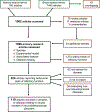A systematic-review of olfactory deficits in neurodevelopmental disorders: From mouse to human
- PMID: 33610612
- PMCID: PMC8142839
- DOI: 10.1016/j.neubiorev.2021.02.024
A systematic-review of olfactory deficits in neurodevelopmental disorders: From mouse to human
Abstract
Olfactory impairment is a common clinical motif across neurodevelopmental disorders, suggesting olfactory circuits are particularly vulnerable to disease processes and can provide insight into underlying disease mechanisms. The mouse olfactory bulb is an ideal model system to study mechanisms of neurodevelopmental disease due to its anatomical accessibility, behavioral relevance, ease of measuring circuit input and output, and the feature of adult neurogenesis. Despite the clinical relevance and experimental benefits, olfactory testing across animal models of neurodevelopmental disease has been inconsistent and non-standardized. Here we performed a systematic literature review of olfactory function testing in mouse models of neurodevelopmental disorders, and identified intriguing inconsistencies that include evidence for both increased and decreased acuity in odor detection in various mouse models of Autism Spectrum Disorder (ASD). Based on our identified gaps in the literature, we recommend direct comparison of different mouse models of ASD using standardized tests for odor detection and discrimination. This review provides a framework to guide future olfactory function testing in mouse models of neurodevelopmental diseases.
Keywords: Anosmia; Hyposmia; Mouse models of neurological disease; Neurodevelopmental disorders; Olfaction; Sensory circuits.
Copyright © 2021 Elsevier Ltd. All rights reserved.
Figures



Similar articles
-
Interventions for the prevention of persistent post-COVID-19 olfactory dysfunction.Cochrane Database Syst Rev. 2022 Sep 5;9(9):CD013877. doi: 10.1002/14651858.CD013877.pub3. Cochrane Database Syst Rev. 2022. PMID: 36063364 Free PMC article.
-
Signs and symptoms to determine if a patient presenting in primary care or hospital outpatient settings has COVID-19.Cochrane Database Syst Rev. 2022 May 20;5(5):CD013665. doi: 10.1002/14651858.CD013665.pub3. Cochrane Database Syst Rev. 2022. PMID: 35593186 Free PMC article.
-
In mice, discrete odors can selectively promote the neurogenesis of sensory neuron subtypes that they stimulate.Elife. 2025 Jun 18;13:RP96152. doi: 10.7554/eLife.96152. Elife. 2025. PMID: 40531183 Free PMC article.
-
Interventions for the treatment of persistent post-COVID-19 olfactory dysfunction.Cochrane Database Syst Rev. 2022 Sep 5;9(9):CD013876. doi: 10.1002/14651858.CD013876.pub3. Cochrane Database Syst Rev. 2022. PMID: 36062970 Free PMC article.
-
Pathophysiological relationship between COVID-19 and olfactory dysfunction: A systematic review.Braz J Otorhinolaryngol. 2022 Sep-Oct;88(5):794-802. doi: 10.1016/j.bjorl.2021.04.001. Epub 2021 Apr 25. Braz J Otorhinolaryngol. 2022. PMID: 33965353 Free PMC article.
Cited by
-
Legacies of salient environmental experiences-insights from chemosensation.Chem Senses. 2024 Jan 1;49:bjae002. doi: 10.1093/chemse/bjae002. Chem Senses. 2024. PMID: 38219073 Free PMC article.
-
Are Multiple Chemosensory Systems Accountable for COVID-19 Outcome?J Clin Med. 2021 Nov 28;10(23):5601. doi: 10.3390/jcm10235601. J Clin Med. 2021. PMID: 34884303 Free PMC article. Review.
-
Olfactory bulb anomalies in KBG syndrome mouse model and patients.BMC Med. 2024 Apr 15;22(1):158. doi: 10.1186/s12916-024-03363-6. BMC Med. 2024. PMID: 38616269 Free PMC article.
-
Olfactory bulb interneurons - The developmental timeline and targeting defined by embryonic neurogenesis.Mol Cell Neurosci. 2025 Jun;133:104007. doi: 10.1016/j.mcn.2025.104007. Epub 2025 Mar 22. Mol Cell Neurosci. 2025. PMID: 40122272
-
Olfactory Development and Dysfunction: Involvement of Microglia.Physiology (Bethesda). 2025 Mar 1;40(2):0. doi: 10.1152/physiol.00037.2024. Epub 2024 Nov 5. Physiology (Bethesda). 2025. PMID: 39499248 Free PMC article. Review.
References
-
- Alvarez-Buylla A Mechanism of migration of olfactory bulb interneurons. Semin Cell Dev Biol. 1997. April;8(2):207–13. - PubMed
-
- Balasubramanian R, Crowley WF. Isolated Gonadotropin-Releasing Hormone (GnRH) Deficiency. In: Adam MP, Ardinger HH, Pagon RA, Wallace SE, Bean LJH, Stephens K, Amemiya A, editors. GeneReviews® [Internet]. University of Washington, Seattle; Seattle (WA): May 23, 2007.
Publication types
MeSH terms
Grants and funding
LinkOut - more resources
Full Text Sources
Other Literature Sources
Medical

